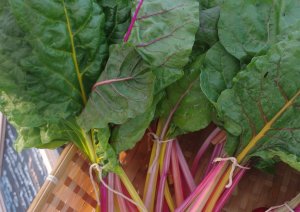
Chard and kale are among the healthiest veggies you can eat, ranking 3rd and 15th respectively in a recent list of Powerhouse Fruits and Vegetables by the Centers for Disease Control. They are also delicious, beautiful and super easy to incorporate into your diet. If you’re like us, you eat a few staple dishes for most meals. Most nights, it is easier to make a long-eaten, well-known dinner, rather than try a totally new dish. Chard and kale are totally ok with this! They are flexible and accommodating and very glad to go along for your standard fare.
Around here, we eat a lot of pizza and pasta. There is a 50% chance that if you come over for a meal, you will be eating pizza or pasta. (In fact, we’ll be having pizza tonight with the scraps of bread dough from making baguettes!). We’ve been adding chard and kale to our pizzas, and using it to top pasta, for a boost of nutrition, flavor, and feel-goodery. Just chop the leaves and stalks into manageable pieces, and throw on top of the pie along with your other toppings. The chard stalks are so pretty, everyone will want to eat it! Use the same method for adding these greens to omelets or quiches as well.

For pasta, we have a well-established summer tradition of making What’s Ready in the Garden Pasta. You take whatever the garden gives you, in this case leaves and stems from the chard, and leaves from kale, sauté it with olive oil, garlic and herbs (lots of basil here), and throw it on top of pasta. Sometimes we add bacon or kielbasi. Easy, nutritious, one-plate meal.

Having a burger for dinner? Put chard on top instead of lettuce! Cooking up some stir fry? Throw in the chard and kale!
See what I’m saying? Totally flexible and accommodating. Also, delicious and healthy!















